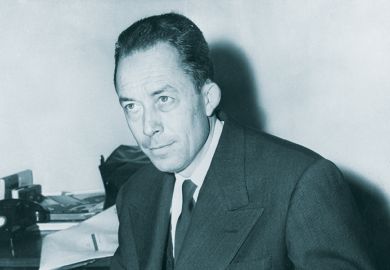The lives of the Romantic poets have always been of great popular interest. Ever since Wordsworth mourned the passing of the years after he "bounded like a roe" in Lines Written A Few Miles Above Tintern Abbey or Coleridge described the interruption of his opium dream by the visitor from Porlock in the preface to Kubla Khan, the public has been intrigued by what it considered the colourful lives of the Lakeland poets. Biography has necessarily been central to the understanding of their writing. But the question has remained: what is important or relevant in the description of a life? Shelley mocked Wordsworth for repressing references to sexuality in his description of a poet's development, while De Quincey argued that Coleridge had been economical with the truth over his opium addiction. Critics are now starting to recognise that the Romantics' self-mythologisation of their lives was as much an art as their writing.
In A Passionate Sisterhood, Kathleen Jones gives a different perspective on what is relevant in the life of a Romantic poet. Like a type of Rosencrantz and Guildenstern are Dead, Jones's book relegates the central characters of Wordsworth, Coleridge and Southey to walk-on parts while allowing their sisters, wives and daughters, normally marginal figures in the story, to take centre stage. While isolated biographies of the Lakeland women, such as Molly Lefebure's timely defence of Mrs Coleridge - The Bondage of Love (1986) - have previously appeared, Jones is the first to consider them as a group. Drawing upon an impressive archive of the women's published and unpublished letters, she traces the destinies of the Fricker sisters, who became the wives of Coleridge, Southey and Robert Lovell, and of the Hutchinson sisters, who joined Wordsworth's household as wife and sister-in-law, and demonstrates that the links between the poets was as much based upon the kinship and friendship ties of the women as on commonly shared views of poetry.
Jones's different perspective allows one to appreciate the material conditions of the male poets' lives. Wordsworth expressed what has been described as the "Romantic ideology" of isolation and other-worldliness when he wrote of wandering "lonely as a cloud", but Jones's book reveals that his sister Dorothy had lost most of her teeth by the time she was 30, that he and Dorothy mostly lived on oatcakes and porridge and that "the emotion recollected in tranquility" of his poetry actually brought on acute physical suffering. Wordsworth's son John suffered from dyslexia; his daughter Dora was plagued by acne that even spa waters from Harrogate would not clear. Similarly Jones reveals that Coleridge's house in Nether Stowey, in which he wrote This Lime Tree Bower My Prison, was small, damp, overun with mice and very unsuitable for his wife Sarah who was struggling to care for a succession of babies.
Coleridge, in fact, comes out extremely badly when viewed from the perspective of his wife, who has been much maligned by critics and biographers. Attractive and intelligent, Sarah Coleridge was left to cope with the demands of everyday living and a growing number of children while her irresponsible husband escaped either abroad, to Germany (ten months) and Malta (two and a half years), or to the more exciting household of William and Dorothy Wordsworth. Dorothy Wordsworth flattered Coleridge, praising his poetry and telling him what he wanted to hear, while his wife, whom Jones suggests was always more spirited and independent, refused to take on the traditional female role of fair-copying her husband's poems. Indeed, Dorothy launched a long-lasting campaign against Sarah, criticising the upbringing of her children and her treatment of her husband, and encouraging Coleridge's passion for Sara Hutchinson. Biographies of Coleridge, Jones suggests, have been wrongly influenced by Dorothy's biased and unkind opinions ever since.
Dorothy and William Wordsworth both emerge from Jones's book as self-centred, eccentric and actually quite cruel people. When they first moved to Racedown in Dorset, they adopted a young child, Basil Montague, whom they used to shut up in a room alone whenever he cried until he was quiet. After the decision was made to visit Germany with Coleridge, they abandoned Basil without compunction. Later they sent William's daughter Dora away to boarding school from the age of four, despite her obvious unhappiness, and William jealously refused to consent to her marriage to Edward Quillinam for many years before he finally succumbed when she was 37.
Jones considers at some length the rumours, current even at the time but dismissed briskly in the Robert Gittings and Jo Manton biography of Dorothy, that the relationship between William and Dorothy was unnaturally close. The two often shared the same bed, were seen kissing by neighbours and seem to have felt great pangs on separation. Dorothy was "undoubtedly in love with William", Jones concludes, but it is "irrefutable" that they were not physically lovers. However, Dorothy did make it clear to Mary Hutchinson that in marrying William, Mary was uniting herself with both siblings ("do not make loving us your business") and later she attempted to supplant Mary in her own son's affections. When Mary was away with her son, Dorothy wrote, "he was never happy with her and never felt himself safe but in my arms". When Dorothy finally succumbs to dementia in Jones's book, one is almost driven to feeling that the illness is some well-deserved nemesis.
The portrait of Dorothy is probably particularly unattractive because her writing hardly features at all in the book. Indeed Jones dwells very little on the literary skills of the women. Sara Coleridge, Coleridge's daughter, is shown to have possessed the greatest literary merit, having published various successful translations and written poetry. Her poetic aspirations clashed with her marriage and family commitments and at one point she stayed alone in an inn, claiming to be ill but actually enjoying the peace to write, for six weeks before her husband arrived in exasperation to fetch her home. In a climate in which women were expected not to be intellectual, any bluestocking's worst critics were likely to be other women. Dorothy Wordsworth, for example, was pleased when Dora lost her imaginative independence and became "thoughtful, steady and womanly" while Sara Hutchinson noted with disapproval that Sara Coleridge "is somewhat spoilt by so much learning". It is a shame that Jones did not concentrate more on the women's writing and so help to rebuff the anti-intellectual picture we have of their lives.
A Passionate Sisterhood is a good book for bedtime reading as well as for study. It is full of soap-opera drama, packed with life-threatening illnesses, lovers' tiffs and numerous births and deaths. But while it panders to our basic curiosity about the behind-the-scenes details of any celebrated life, it also raises serious questions about the nature of Romantic biography and the hidden costs and weaknesses of the male Romantic imagination, which the women nurtured and bore with patience. As Sarah Coleridge, the book's surprise heroine, put it with typical understatement, pointing out the limitations of her husband's imagination before reality:
"I pray to God that I may never live to behold the death of another child, for O my dear Samuel! it is a suffering beyond your conception!" Jennifer Wallace is lecturer and director of studies in English, Peterhouse, Cambridge.
A Passionate Sisterhood: The Sisters, Wives and Daughters of the Lake Poets
Author - Kathleen Jones
ISBN - 0 09 476430 1
Publisher - Constable
Price - £20.00
Pages - 313
Register to continue
Why register?
- Registration is free and only takes a moment
- Once registered, you can read 3 articles a month
- Sign up for our newsletter
Subscribe
Or subscribe for unlimited access to:
- Unlimited access to news, views, insights & reviews
- Digital editions
- Digital access to THE’s university and college rankings analysis
Already registered or a current subscriber? Login



